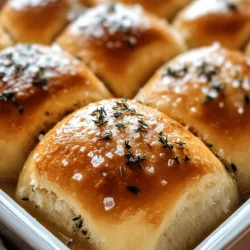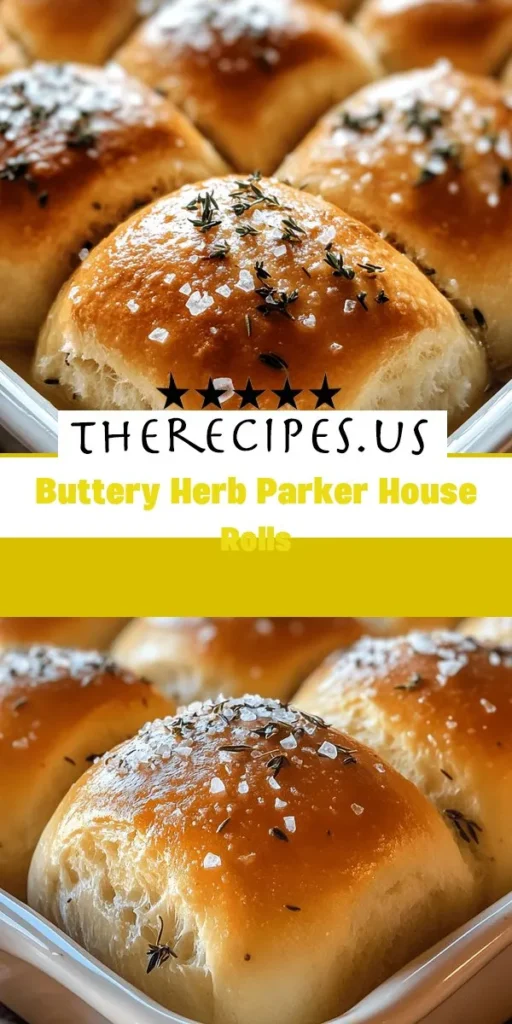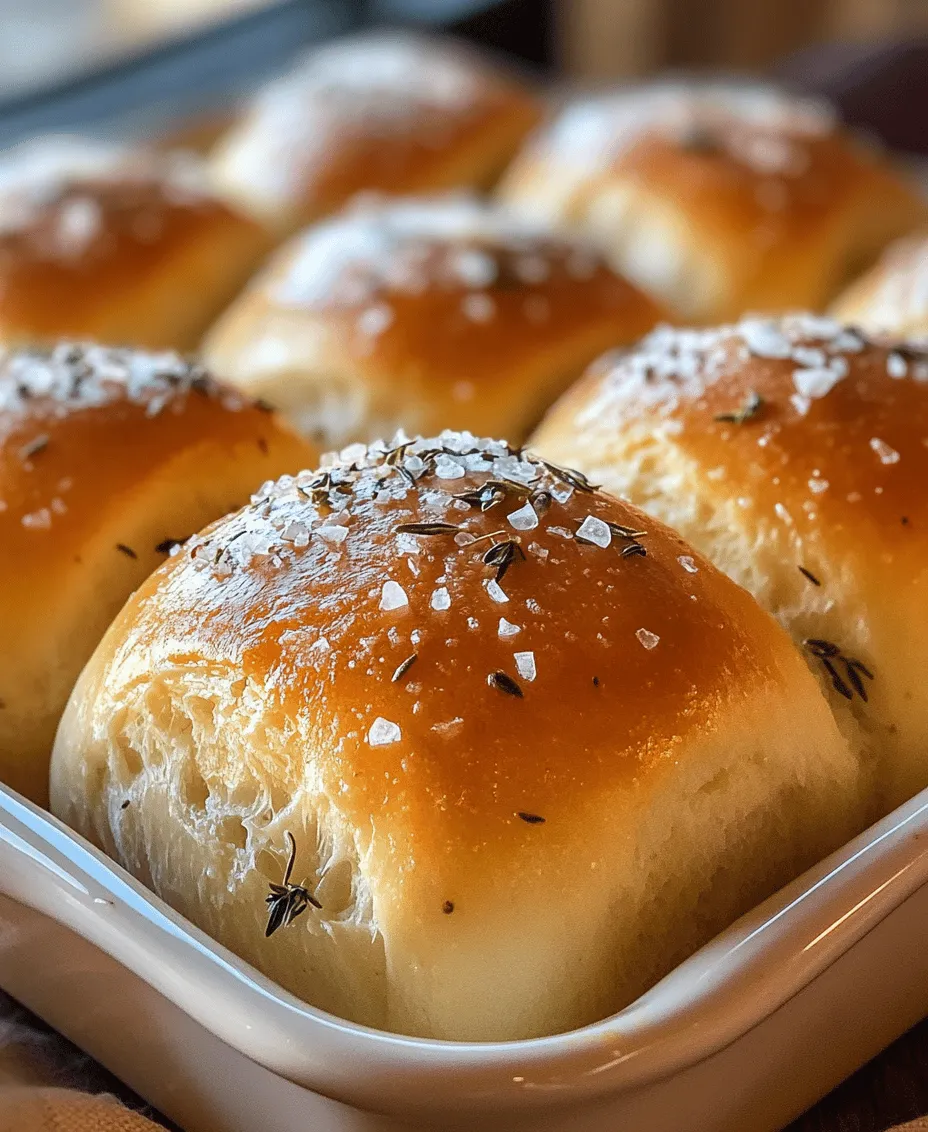Introduction
There’s something undeniably enchanting about the aroma of homemade bread wafting through your kitchen. The warm, inviting scent of baking rolls can transform a simple evening into a delightful experience, filling your home with comfort and nostalgia. Among the many varieties of bread, Buttery Herb Parker House Rolls stand out as a quintessential comfort food that elevates any meal. These rolls are perfect for family dinners, holiday celebrations, or even just a cozy night in.
What sets these Parker House Rolls apart is their unique blend of fresh herbs, which takes the traditional recipe to a new level of gourmet deliciousness. Imagine biting into a soft, pillowy roll, the buttery richness complemented by the vibrant flavors of herbs like rosemary, thyme, and parsley. These rolls not only serve as a delightful side but also as a star of the table, enticing guests with their enticing appearance and aromatic profile.
In this article, we will explore the history of Parker House Rolls, delve into the essential ingredients that make this recipe shine, and guide you through the initial steps of preparing your own batch of Buttery Herb Parker House Rolls.
Understanding Parker House Rolls
Parker House Rolls have a rich and storied history that dates back to the 19th century in Boston, Massachusetts. Named after the Parker House Hotel, where they were first served, these rolls have become a beloved staple in American cuisine. Their origin story is as delightful as their taste; legend has it that they were created by a chef who accidentally folded the dough, resulting in the soft, layered texture we enjoy today.
Traditionally, Parker House Rolls are known for their buttery flavor and light, fluffy consistency. The unique folding technique creates a tender crumb that pairs beautifully with butter and honey. However, our recipe introduces a twist—infusing the rolls with a medley of fresh herbs. This addition not only enhances the flavor profile but also adds a touch of sophistication, making them a perfect accompaniment to roasted meats, soups, or even enjoyed on their own.
The Importance of Ingredients
To create the perfect Buttery Herb Parker House Rolls, understanding each ingredient’s role is crucial. Here’s a closer look at the key components of this recipe:
All-Purpose Flour
The foundation of any bread recipe is flour, and for our rolls, all-purpose flour is the ideal choice. This versatile flour has a moderate protein content, typically around 10-12%, which provides the right balance of structure and tenderness. When you sift the flour before measuring, it aerates the flour, resulting in a lighter texture in the final product. This step helps to prevent dense rolls and ensures that they rise beautifully.
Active Dry Yeast
Yeast is the magical ingredient that makes our rolls rise. Active dry yeast is a type of leavening agent that ferments sugars in the dough, producing carbon dioxide and alcohol, which in turn causes the dough to expand. The temperature at which you activate the yeast is critical; too hot, and you kill the yeast; too cold, and it won’t activate. For optimal results, use warm water or milk (around 110°F) to awaken the yeast, ensuring a successful rise.
Warm Milk
Warm milk serves multiple purposes in this recipe. First, it acts as a liquid for the yeast, helping it to activate and flourish. Secondly, warm milk contributes to the tenderness of the rolls, enriching the dough and providing moisture. The fat content in milk also adds to the overall flavor and richness of the rolls, making them soft and delectable.
Unsalted Butter
Butter is a crucial ingredient in any bread recipe, and in our Buttery Herb Parker House Rolls, it plays a dual role. Not only does it add flavor, but it also enhances the moisture and texture. Unsalted butter is preferred, as it allows you to control the salt levels in your dough. The butter should be softened to room temperature for easy incorporation into the dough, ensuring a smooth and even distribution.
Fresh Herbs
The addition of fresh herbs is what elevates these rolls from ordinary to extraordinary. While dried herbs can be convenient, fresh herbs provide a vibrant flavor and aroma that can’t be replicated. Depending on your preference, you can choose a combination of herbs such as rosemary, thyme, and parsley. Chopping the herbs finely before adding them to the dough will ensure that their flavors are evenly distributed throughout the rolls, resulting in a delightful taste in every bite.
Step-by-Step Guide to Making Buttery Herb Parker House Rolls
Now that we’ve set the stage for this delightful recipe and explored the importance of each ingredient, it’s time to dive into the step-by-step process of making Buttery Herb Parker House Rolls. Let’s begin with the first crucial step: preparing the yeast.
Step 1: Preparing the Yeast
The first step in creating your Buttery Herb Parker House Rolls involves activating the yeast. This process is essential, as it ensures that your rolls will rise and achieve that light, fluffy texture we all love. Here’s how to do it:
1. Dissolve the Sugar: In a small bowl, combine about one tablespoon of sugar with 1/4 cup of warm milk or water. This sugar acts as food for the yeast and helps it to activate more effectively.
2. Add the Yeast: Sprinkle the active dry yeast over the warm milk mixture. Gently stir to combine, and then let it sit for about 5 to 10 minutes. During this time, you should see bubbles forming on the surface. This bubbling indicates that the yeast is active and ready to leaven your dough.
3. Check the Temperature: If you don’t see any bubbles after 10 minutes, it’s likely that the yeast is either too old or the temperature was not ideal. In this case, you’ll need to start over with fresh yeast and ensure that your liquid is warm, but not hot.
With the yeast activated, you’re ready to move on to mixing the dough. This initial step is crucial, as it sets the foundation for your rolls, ensuring they rise beautifully and have that signature fluffy texture.
Stay tuned for the next steps where we will combine all the ingredients to create the dough and continue on the journey towards your delicious Buttery Herb Parker House Rolls.
Making the Dough
To create the perfect Buttery Herb Parker House Rolls, the first step involves mixing the ingredients to form the dough. Start by combining the warm milk, sugar, and yeast in a mixing bowl. Allow this mixture to sit for about 5-10 minutes until it becomes frothy. This indicates that the yeast is active, which is crucial for the dough’s rise.
Once the yeast is activated, add the melted butter, eggs, and salt to the mixture. Gradually incorporate the flour, one cup at a time, until the dough begins to come together. This step highlights the importance of hydration in dough preparation. Flour absorbs water differently, and achieving the right hydration level can vary based on the flour type and humidity. The dough should be slightly sticky but not overly wet; adjust the flour or milk as necessary to reach this consistency.
Kneading the Dough
Kneading is essential for developing gluten, which gives the rolls their structure and chewiness. Turn the dough out onto a lightly floured surface and begin kneading by pushing the dough away from you with the heels of your hands, then folding it back over itself. Rotate the dough a quarter turn and repeat. Knead for about 8-10 minutes until the dough is smooth and elastic.
To assess the dough’s texture, perform the “windowpane test”: take a small piece of dough and stretch it gently. If it forms a thin, translucent membrane without tearing, you have kneaded it sufficiently. This indicates that the gluten is well-developed and ready for the first rise.
First Rise
The first rise, or bulk fermentation, is crucial for the flavor and texture of your rolls. This is when the dough develops its structure and air pockets. Transfer the kneaded dough to a greased bowl, cover it with a damp cloth or plastic wrap, and place it in a warm, draft-free area. An ideal temperature for rising is around 75°F to 80°F.
Allow the dough to rise until it has doubled in size, which typically takes about 1-2 hours. If your kitchen is cool, you can create a warm environment by placing the bowl in the oven with the light on or near a heater. This rise not only contributes to the dough’s flavor but also ensures a light and airy texture in the final product.
Preparing the Herb Mixture
While the dough is rising, prepare the herb mixture that will infuse the rolls with flavor. Select fresh herbs such as parsley, chives, and thyme for the best taste. Rinse the herbs under cold water and pat them dry with a paper towel. Using a sharp knife, finely chop the herbs, ensuring they are uniform in size to distribute their flavor evenly throughout the rolls.
Balancing the flavors is key; you want the herbs to enhance the buttery richness of the rolls without overpowering them. Aim for a combination that complements the other ingredients. For example, parsley adds a fresh note, while thyme provides an earthy depth. Set the herb mixture aside until the dough has completed its first rise.
Shaping the Rolls
After the first rise, punch down the dough to release any trapped air. Turn it out onto a floured surface and gently flatten it into a rectangle, roughly ½ inch thick. Use a pizza cutter or a sharp knife to cut the dough into equal squares or rectangles, typically about 2-3 inches in size.
To shape each roll, take a piece of dough and stretch it slightly. Then, fold the edges towards the center and pinch them together, creating a neat ball. Place each shaped roll seam-side down into a greased baking dish, ensuring they are close together but not touching. This technique encourages the rolls to rise upwards, creating a delightful fluffy texture.
Second Rise
The second rise is just as important as the first, allowing the shaped rolls to puff up before baking. Cover the baking dish with a cloth and let the rolls rise in a warm environment for another 30-45 minutes. During this time, the rolls will expand and fill the gaps in the dish, which contributes to their soft, pillowy texture.
This step also allows the flavors from the herb mixture to meld with the dough, enhancing the overall taste. If you’re short on time, a shorter second rise can still yield good results, but allowing more time will produce a lighter roll.
Preparing for Baking
Before baking, it’s essential to prepare the rolls for that beautiful golden finish. In a small bowl, whisk together an egg with a splash of water to create an egg wash. Using a pastry brush, gently apply this mixture to the tops of the rolls. The egg wash not only gives the rolls a shiny, attractive crust but also helps any toppings, such as sea salt, adhere better.
Sprinkle a pinch of flaky sea salt over the rolls after applying the egg wash. This final touch enhances the flavor, providing a delightful contrast to the buttery richness of the rolls.
Baking the Rolls
Preheat your oven to 375°F (190°C) while the rolls are undergoing their second rise. Once the rolls have puffed up, place the baking dish in the oven and bake for 20-25 minutes or until the tops are golden brown. To check for doneness, tap the bottom of a roll; it should sound hollow. Alternatively, an instant-read thermometer inserted into the center of a roll should read around 190°F (88°C) when fully baked.
Brushing with Butter
As soon as the rolls come out of the oven, brush them generously with melted butter. This step not only adds flavor but also gives the rolls a luxurious appearance. The butter seeps into the cracks and crevices, enhancing their richness and making them irresistible.
Serving Suggestions and Pairings
Buttery Herb Parker House Rolls are a versatile addition to any meal. Serve them warm with a pat of soft butter for a classic pairing, or elevate your serving experience with flavored butters such as garlic herb butter or honey butter. These rolls also complement a variety of dishes; they can be served alongside roasted meats, stews, or even as a part of a festive holiday spread.
For a more sophisticated touch, consider pairing these rolls with artisanal jams or chutneys. The herb flavors work beautifully with savory dishes like roasted chicken or grilled vegetables, making them suitable for both casual dinners and special occasions.
Nutritional Information
Enjoying Buttery Herb Parker House Rolls can be part of a balanced diet. Each roll contains approximately 120 calories, with 5 grams of fat and 15 grams of carbohydrates. While these rolls are a delightful treat, it’s important to enjoy them in moderation, especially if you are watching your caloric intake. The use of fresh herbs not only enhances flavor but also adds nutritional value, providing vitamins and minerals that can contribute positively to your meal.
Conclusion
Baking Buttery Herb Parker House Rolls is not just about creating a delicious side dish; it is an experience that brings joy to both the baker and those who enjoy the final product. The process of kneading, rising, and baking transforms simple ingredients into something truly special. These rolls can elevate everyday meals and add a touch of warmth to gatherings and festivities.
Whether you are an experienced baker or trying your hand at bread-making for the first time, these rolls are approachable and yield impressive results. Embrace the art of baking in your kitchen, and let the aroma of freshly baked rolls fill your home, inviting loved ones to gather around the table.



